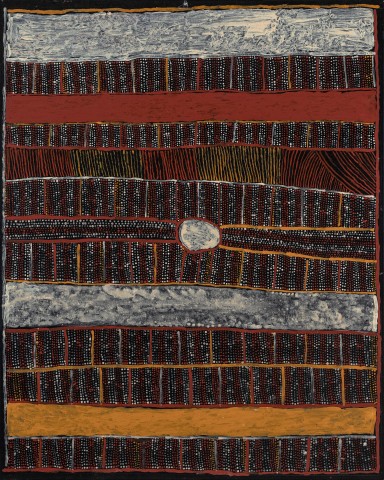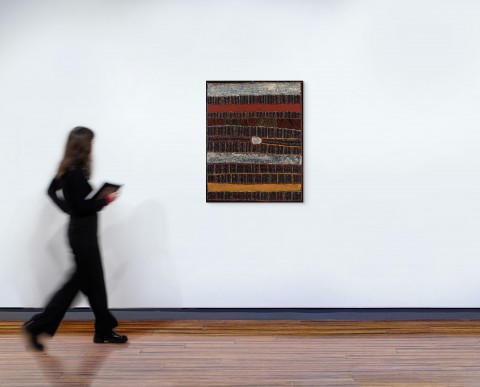UNTITLED, 2000
KITTY KANTILLA (KUTUWULUMI PURAWARRUMPATU)
natural earth pigments and synthetic binder on canvas
100.5 x 81.0 cm
bears inscription and stamp verso: artist’s name and Jilamara Arts cat. 140-00
Jilamara Arts, Melville Island, Northern Territory (stamped verso)
Aboriginal and Pacific Art, Sydney
Private collection, Sydney
Kitty Kantilla; New Works on Paper and Canvas, Aboriginal and Pacific Art, Sydney, 7 – 23 December 2000
Meridian: Focus on Contemporary Australian Art, Museum of Contemporary Art, Sydney, 28 February 2002 – 23 February 2003
Kitty Kantilla, National Gallery of Victoria, Melbourne, 27 April – 19 August 2007; Art Gallery of New South Wales, Sydney, 7 December 2007 – 21 January 2008, cat. 60 (label attached verso)
Ryan, J., Kitty Kantilla, National Gallery of Victoria, Melbourne, 2007, p. 46 (illus.)
In response to her solo exhibition in December 2000 held at Aboriginal and Pacific Art in Sydney, art critic Sebastian Smee lauded the art of Kitty Kantilla as reminiscent of Italian still life painter Giorgio Morandi: ‘Her brilliant and original works vibrate with a moment-to-moment immediacy: nothing is allowed to settle into monotony… as well, she knows how leave things out... she lets the various elements breathe.’1
Reproduced on the invitation for the December 2000 Sydney exhibition and painted on a black ground, Untitled, 2000 encompasses all the elements of the artist’s lexicon. Pwanga (dots), marlipinyini (lines), and turtiyangimari (colours including white, red, yellow and black) all feature, however here the painting opens up with rhythmic movement – blocks of ochre dots separated by vertical lines are contained between wide horizontal bands of red and yellow ochre and smokey white clay. Although seemingly abstract in appearance, Kantilla’s mark making is far from arbitrary; rather her designs evoke cultural history and ritual, particularly the Pukumani ceremony, where the Tiwi gather to farewell the dead and performers in full body decoration participate in a cycle of song and dance.
In the catalogue to Kantilla’s National Gallery of Victoria retrospective in 2007, Judith Ryan describes Kantilla’s approach: ‘She is able to distil and pare back figurative elements so that her work, like an analytic cubist still life, reduces form to structure and partakes of the quality of inwardness. The balancing patterns of red, yellow and white ochre in counterpoise with constant rows of alternating ochre dots on black or white, results in work of overriding presence and great beauty, borne of restraint and imbued with adagio rhythm.’2
1. Smee, S., ‘The Poet of Small things’, Sydney Morning Herald, 22 December 2000 p. 22, cited in Ryan, J., Kitty Kantilla, National Gallery of Victoria, Melbourne, 2007 p. 81
2. Ryan, ibid., p. 82
CRISPIN GUTTERIDGE

